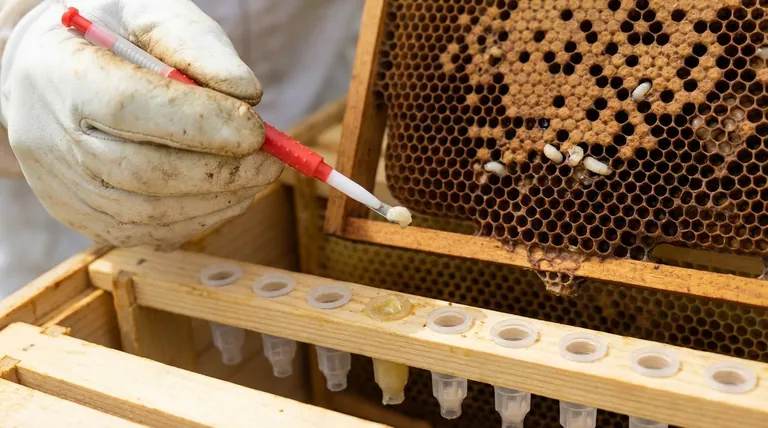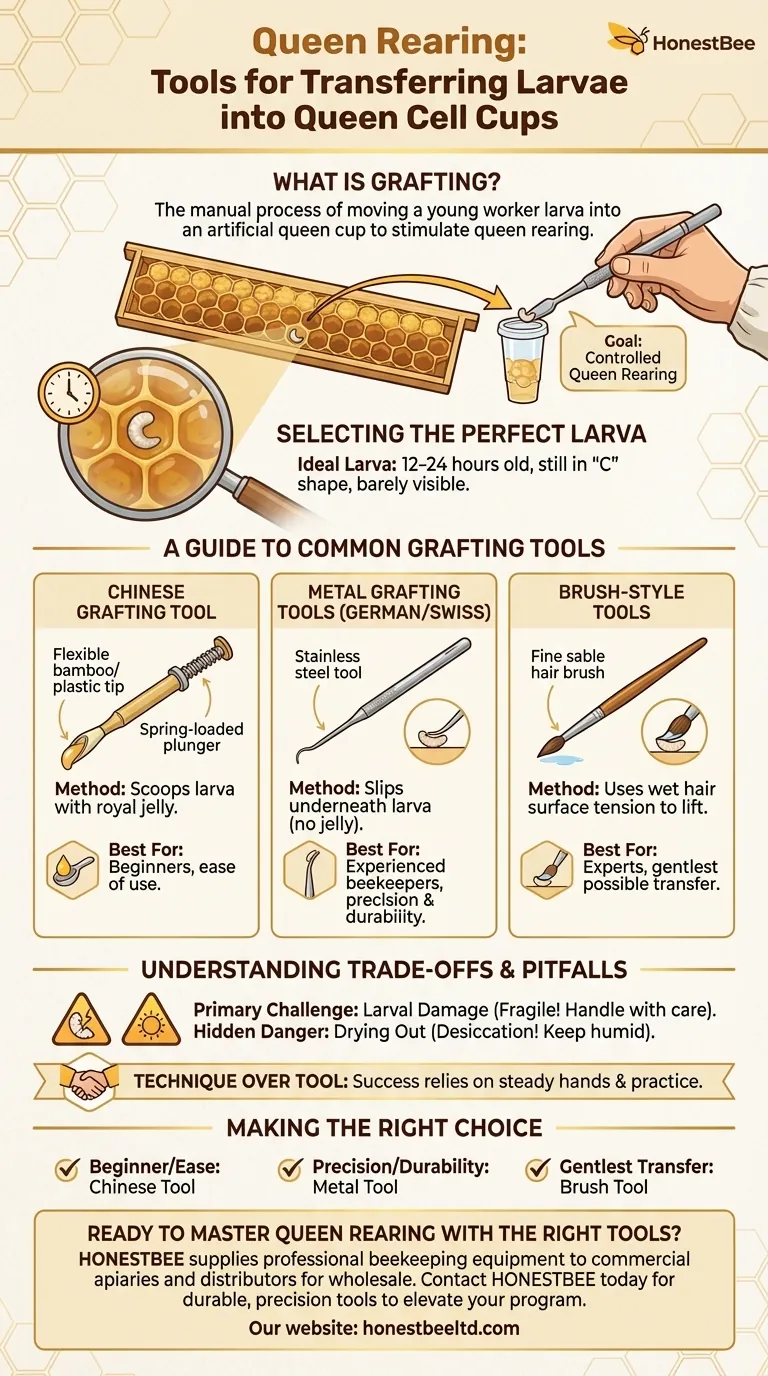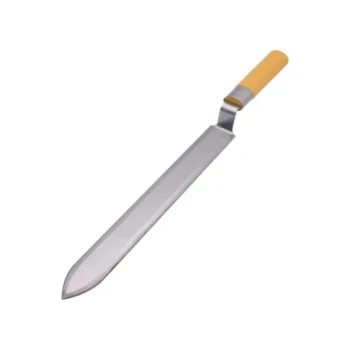The primary instruments used to transfer larvae into queen cell cups are known as grafting tools. This delicate process, called grafting, is a cornerstone of queen rearing, allowing a beekeeper to select larvae from a desirable colony and raise a large number of new queens. The choice of tool depends on the beekeeper's skill, preference, and the scale of their operation.
While several types of grafting tools exist, success in queen rearing is less about the specific tool and more about the technique: selecting a larva of the correct age and performing the transfer with a steady, gentle hand.

What is Grafting in Beekeeping?
Grafting is the manual process of moving a single, very young worker larva from its original cell into an artificial queen cup. This action stimulates a "finisher" colony to raise that larva into a new queen.
The Goal: Controlled Queen Rearing
In nature, a colony creates a new queen when the old one fails or when the colony prepares to swarm. Grafting allows the beekeeper to control this process, selecting genetic stock from their best hives (e.g., those that are gentle, productive, or disease-resistant) to create many new queens on a predictable schedule.
Selecting the Perfect Larva
This is the most critical step. The ideal larva is 12 to 24 hours old, barely visible to the naked eye, and still curled in a "C" shape at the bottom of the cell. These young larvae have not yet had their diet changed from royal jelly to a mix of pollen and honey, making them ideal candidates for the colony to raise as queens.
A Guide to Common Grafting Tools
Beekeepers have a few common options, each with distinct advantages. The fundamental difference is how they pick up the larva.
The Chinese Grafting Tool
This is arguably the most popular tool, especially for beginners. It typically has a thin, flexible plastic or bamboo reed with a tiny scoop at the end. A spring-loaded plunger helps gently push the larva off the scoop and into the queen cup.
Its main advantage is that it scoops the larva along with a small bed of royal jelly, which prevents the larva from drying out and provides a nutritional base in the new cup.
Metal Grafting Tools (German or Swiss Style)
These precision tools are made from stainless steel and feature an extremely fine, flexible tip. Unlike the Chinese tool, they are designed to slip underneath the larva's body to lift it out of its cell without the surrounding royal jelly.
This requires more skill and a steadier hand but is preferred by many experienced beekeepers for its durability and precise feel. It is a true test of a delicate touch.
Brush-Style Tools
Some beekeepers prefer using a single, fine sable hair from an artist's brush. The tip of the hair is wetted, and the surface tension is used to lift the tiny larva from its cell.
This method is exceptionally gentle but is also the most difficult to master. It offers the least potential for physical damage to the larva if performed correctly.
Understanding the Trade-offs and Pitfalls
The tool itself is only one part of a successful graft. Technique and environment are just as important.
The Primary Challenge: Larval Damage
The larva is incredibly fragile. A clumsy transfer can easily puncture or crush it, rendering it useless. The Chinese tool can be more forgiving as it supports the larva in jelly, while metal tools require greater finesse to avoid injury.
The Hidden Danger: Drying Out (Desiccation)
Larvae are extremely susceptible to drying out. Removing them from the high-humidity environment of the hive for even a few minutes can be fatal. Grafting should be done quickly in a humid environment, often with a damp towel nearby to maintain moisture.
Technique Over Tool
An expert can successfully graft with any of these tools, while a beginner will likely struggle regardless of their choice. The key is practicing the gentle scooping or lifting motion and learning to identify larvae of the perfect age. Many beekeepers practice on older drone larvae, which are larger and more expendable.
Making the Right Choice for Your Goal
Your choice of tool should align with your experience level and priorities in queen rearing.
- If you are a beginner or value ease of use: The Chinese grafting tool is the most forgiving and widely recommended starting point.
- If you prioritize precision and long-term durability: A high-quality metal grafting tool is an excellent investment once you have mastered the basic technique.
- If your sole focus is the most gentle transfer possible: A fine hair brush may be the ultimate tool, but be prepared for a significant learning curve.
Ultimately, successful queen rearing is achieved through patience, practice, and a deep respect for the delicate biology of the honey bee.
Summary Table:
| Tool Type | Primary Method | Best For |
|---|---|---|
| Chinese Grafting Tool | Scoops larva with royal jelly | Beginners, ease of use |
| Metal Grafting Tool | Slips under larva (no jelly) | Experienced beekeepers, precision |
| Brush-Style Tool | Uses wet hair to lift larva | Experts, gentlest transfer |
Ready to Master Queen Rearing with the Right Tools?
HONESTBEE supplies professional beekeeping supplies and equipment to commercial apiaries and beekeeping equipment distributors through wholesale-focused operations. We provide the durable, precision tools you need for successful grafting and large-scale queen production.
Contact HONESTBEE today to discuss your wholesale equipment needs and elevate your queen rearing program.
Visual Guide

Related Products
- Plastic Chinese Queen Grafting Tool for Bee Queen Rearing
- Black 2 Pack Beekeeper Queen Grafting Tool for Bee Queen Larva Transferring Needle
- Double Head Beekeeping Grafting Tools for Beekeepers
- HONESTBEE 15-in-1 Beekeeper Multi-Tool with Hammer and Pliers for Beekeeping
- HONESTBEE Professional Long Handled Hive Tool with Precision Cutting Blade
People Also Ask
- What conditions should be avoided during grafting? Protect Your Queen Cells from Common Pitfalls
- What are the steps involved in using a queen grafting tool? A Guide to Successful Queen Rearing
- What is the process of shaving the cells for grafting? Improve Queen Rearing Success with This Technique
- What are the steps involved in the grafting process? Master Queen Rearing for Your Apiary
- What are the key steps in the grafting technique? Master Queen Rearing for a Thriving Apiary



















